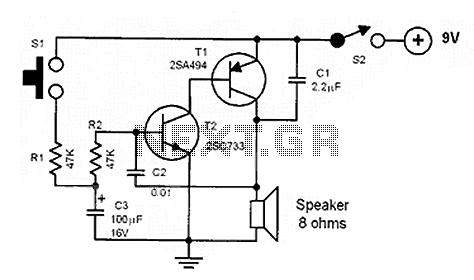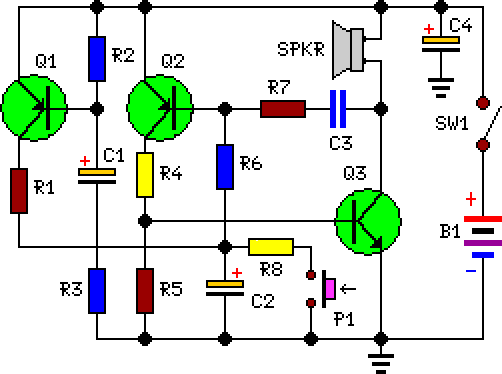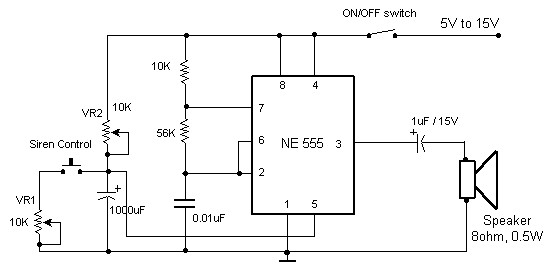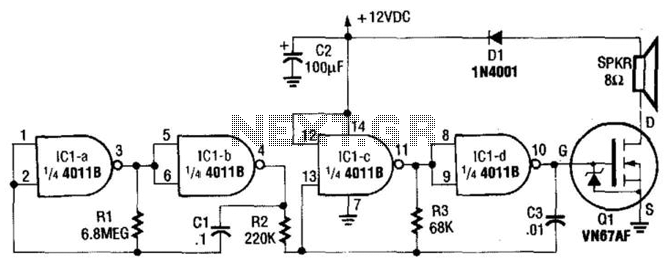
siren 100db
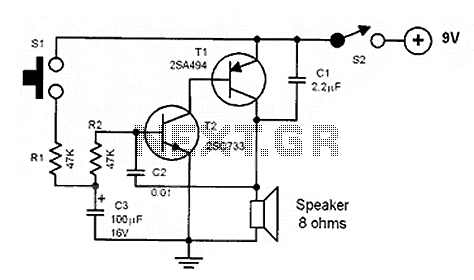
A robber will not remain in an area with an ear-piercing sound, as they cannot hear if someone is approaching. It is the best deterrent available. The "F" contact on the piezo is "feedback" and is not required in this circuit.
The circuit employs a piezoelectric sound generator, which is designed to emit a high-decibel sound that can effectively deter intruders. The primary function of the piezo element is to produce a loud, attention-grabbing noise when activated, making it difficult for a potential robber to remain in the vicinity without being alerted to the presence of others.
In this configuration, the piezo element is connected to a simple trigger mechanism, which can be activated by various sensors, such as motion detectors or pressure switches. When the sensor detects movement or pressure, it completes the circuit, allowing current to flow to the piezo element, thus generating the loud sound.
The circuit design omits the "F" contact, which is typically used for feedback in more complex circuits. This simplification reduces the number of components required and streamlines the design, making it easier to implement and maintain.
Power supply considerations are essential for this circuit, as the piezo element requires sufficient voltage to produce the desired sound level. A battery or a low-voltage power supply can be utilized, depending on the application and the required portability of the device.
Overall, this circuit serves as an effective security measure, leveraging the psychological deterrent of loud noise to prevent unauthorized access and enhance safety.A robber will not stay anywhere with an ear-piercing sound as he cannot hear if someone is approaching. It`s the best deterrent you can get. The "F" contact on the piezo is "feedback" and is not needed in this circuit. 🔗 External reference
The circuit employs a piezoelectric sound generator, which is designed to emit a high-decibel sound that can effectively deter intruders. The primary function of the piezo element is to produce a loud, attention-grabbing noise when activated, making it difficult for a potential robber to remain in the vicinity without being alerted to the presence of others.
In this configuration, the piezo element is connected to a simple trigger mechanism, which can be activated by various sensors, such as motion detectors or pressure switches. When the sensor detects movement or pressure, it completes the circuit, allowing current to flow to the piezo element, thus generating the loud sound.
The circuit design omits the "F" contact, which is typically used for feedback in more complex circuits. This simplification reduces the number of components required and streamlines the design, making it easier to implement and maintain.
Power supply considerations are essential for this circuit, as the piezo element requires sufficient voltage to produce the desired sound level. A battery or a low-voltage power supply can be utilized, depending on the application and the required portability of the device.
Overall, this circuit serves as an effective security measure, leveraging the psychological deterrent of loud noise to prevent unauthorized access and enhance safety.A robber will not stay anywhere with an ear-piercing sound as he cannot hear if someone is approaching. It`s the best deterrent you can get. The "F" contact on the piezo is "feedback" and is not needed in this circuit. 🔗 External reference

